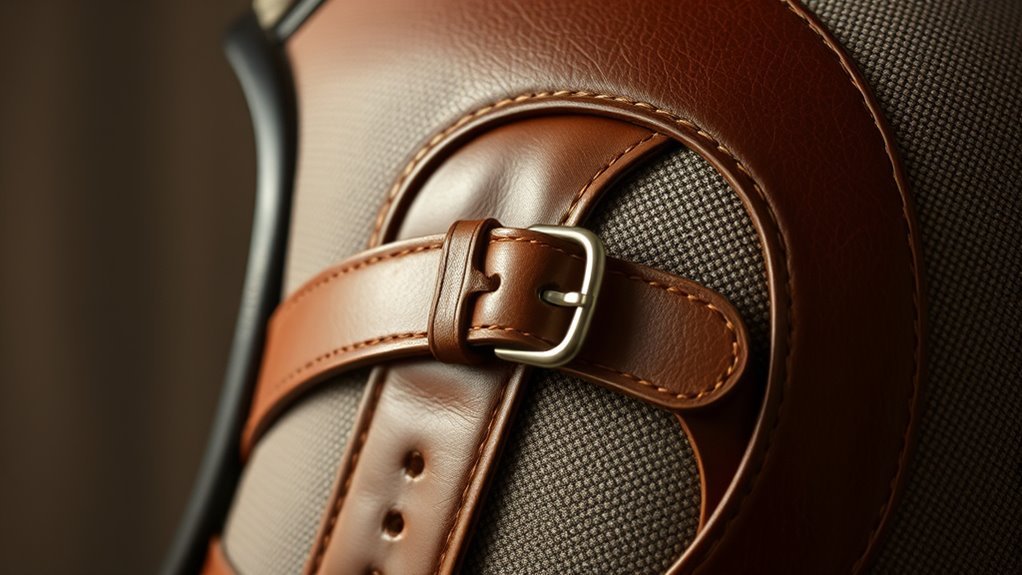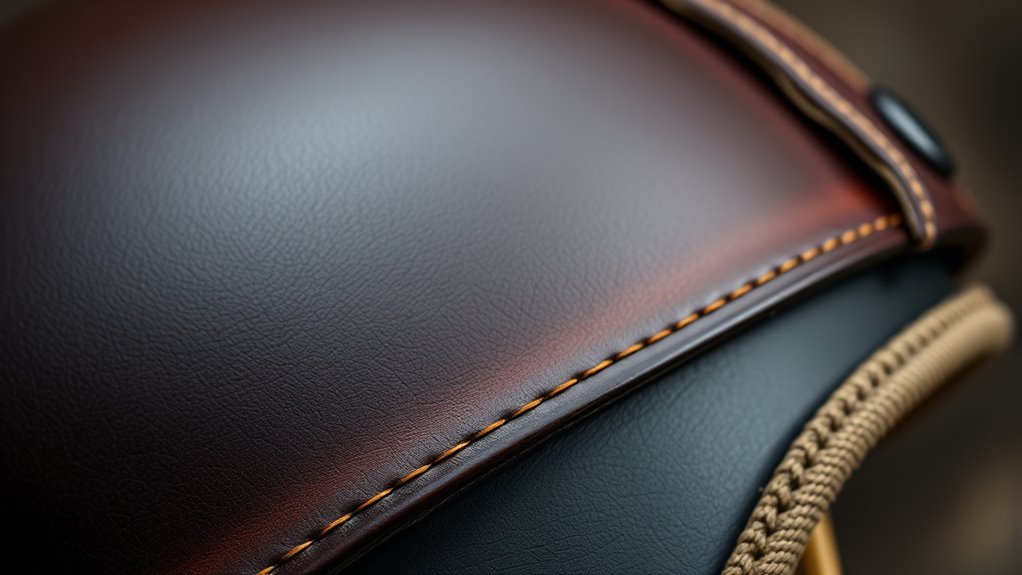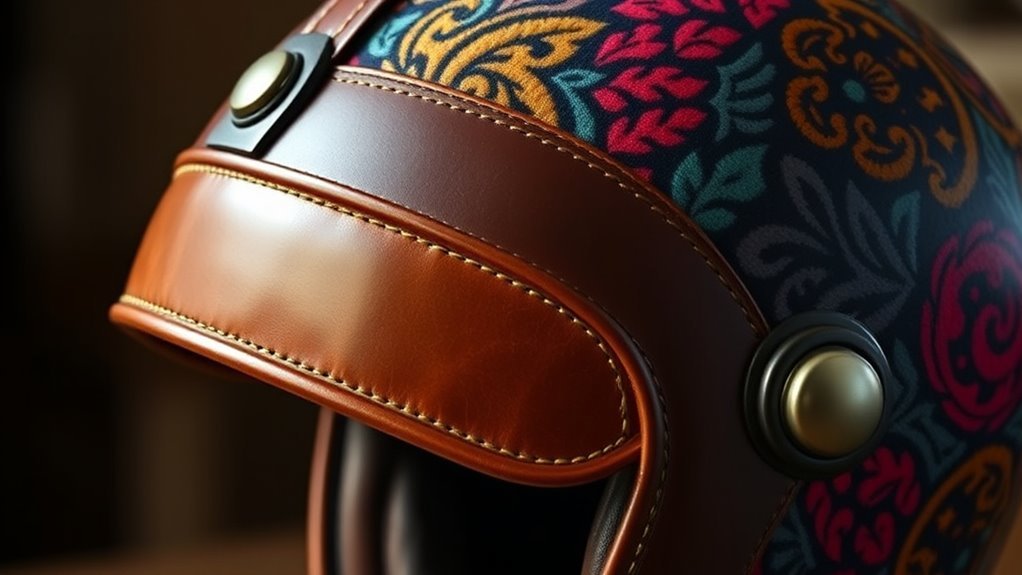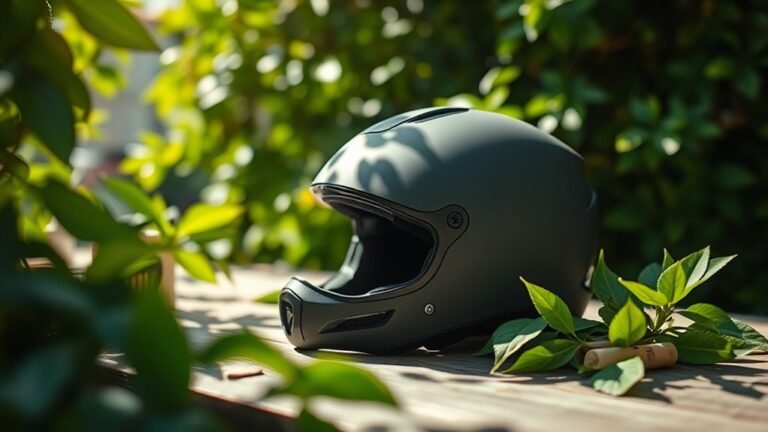Using Fabric and Leather in Helmet Design
Using fabric and leather in helmet design offers a perfect blend of safety, comfort, and style. Fabrics provide breathability and lightweight comfort, while leather adds durability and a tailored fit that ages beautifully. Together, they create helmets that not only protect but also reflect your personal style. With options for customization and maintenance tips, these materials redefine helmet aesthetics and functionality. Explore the endless possibilities of how fabric and leather can elevate your helmet experience.
The Role of Materials in Helmet Safety

When it comes to helmet safety, the materials you choose can make all the difference. Think about it: the right materials undergo rigorous impact assessment and material testing to guarantee they can withstand the forces of an accident. Lightweight composites or advanced fabrics can absorb shock while keeping you comfortable. You want a helmet that feels like a second skin, allowing you the freedom to ride without worry. Each material serves a purpose, from the outer shell designed for durability to the inner foam engineered for impact absorption. By selecting helmets crafted with high-quality materials, you’re not just protecting your head; you’re embracing a safer, more exhilarating experience on the road. Prioritize your safety and freedom with smart material choices.
Benefits of Fabric in Helmet Design

When it comes to helmet design, fabric offers unmatched comfort and breathability, making your ride much more enjoyable. You can also customize the look to reflect your personal style, ensuring that your helmet isn’t just protective, but also a fashion statement. With fabric, you get the best of both worlds—functionality and flair.
Comfort and Breathability
Comfort and breathability are essential attributes in helmet design, especially when it comes to using fabric. When you’re on the move, you want a helmet that feels good and keeps you cool. Breathable fabrics enhance moisture management, ensuring sweat evaporates quickly, so you stay dry and comfortable.
| Feature | Breathable Fabrics | Leather |
|---|---|---|
| Moisture Control | Excellent | Moderate |
| Weight | Lightweight | Heavy |
| Flexibility | High | Low |
| Comfort Level | High | Moderate |
| Temperature Regulation | Ideal | Limited |
Choosing a helmet with fabric means embracing freedom and adventure without sacrificing comfort. You’ll appreciate how it fits into your lifestyle, allowing you to ride with ease.
Customization and Aesthetics
Fabric helmets not only excel in comfort but also offer a unique canvas for customization and aesthetics. You can truly express your individuality with an array of fabric patterns and leather finishes that set your helmet apart. Here’s why fabric is a game-changer:
- Vibrant Designs: Choose from a spectrum of colors and patterns that reflect your style.
- Textured Appeal: Combine smooth leather finishes with rich fabrics for eye-catching contrast.
- Personal Touch: Add patches or embroidery for a personal flair that stands out.
- Lightweight Comfort: Enjoy a stylish look without sacrificing comfort or weight.
With fabric, your helmet becomes more than just gear; it’s a reflection of your freedom and creativity on the road.
Advantages of Leather in Helmets

When you consider leather for helmets, you’re investing in durability that stands the test of time. Not only does leather offer a tailored fit that conforms to your head, but it also provides a level of comfort that synthetic materials often can’t match. This combination guarantees that your helmet not only protects you but does so while feeling great to wear.
Durability and Longevity
While many materials vie for attention in helmet design, leather stands out for its impressive durability and longevity. When you choose leather, you’re investing in a material that exceeds lifespan expectations, ensuring your helmet withstands the test of time. Its material resilience is remarkable, making it a top choice for those who crave freedom on the road.
Here are some advantages of leather in helmets:
- Resistant to wear and tear: Leather ages beautifully, developing a unique patina.
- Water-resistant: It naturally repels moisture, keeping you dry.
- Temperature regulation: Leather provides insulation in winter and breathability in summer.
- Easy maintenance: A simple wipe-down keeps it looking sharp.
With leather, your helmet becomes a dependable companion for every adventure.
Comfort and Fit
Comfort is paramount when it comes to helmet design, and leather excels in providing a snug yet adaptable fit. With its natural flexibility, leather allows for effortless fit adjustments, ensuring your helmet hugs your head just right. This adaptability not only enhances comfort but also promotes better safety.
| Feature | Benefits |
|---|---|
| Fit Adjustments | Customizable for every head shape |
| Padding Options | Enhanced comfort and support |
Comfort and Fit: How Fabric Enhances Wearability
Although traditional materials like leather have long been favored for helmet design, innovative fabrics are redefining wearability by prioritizing comfort and fit. You’ll appreciate how these advancements enhance your experience on the road.
- Breathable materials keep you cool, reducing sweat and discomfort.
- Advanced padding techniques mold to your head shape, providing a custom fit.
- Lightweight fabrics make wearing a helmet feel less cumbersome.
- Fit adjustments allow for easy customization, ensuring a snug yet comfortable experience.
With these features, you can ride freely and confidently, knowing your helmet is designed for maximum comfort and wearability. Embrace the evolution of helmet design and enjoy the journey ahead!
Aesthetic Appeal: Styling With Fabric and Leather
When it comes to styling your helmet, the versatility of fabric and leather opens up a world of possibilities. You can choose from an array of colors and textures, allowing you to express your unique personality while ensuring safety. With the right combination, your helmet can become a standout accessory that complements your style perfectly.
Material Versatility in Design
As you explore the world of helmet design, you’ll discover that the combination of fabric and leather not only enhances functionality but also elevates aesthetic appeal. Embracing material adaptability allows for design innovation that resonates with your desire for individuality. Here’s how fabric and leather transform your helmet experience:
- Personalization: Different textures and colors let you express your unique style.
- Comfort: Soft fabrics paired with robust leather provide a cozy yet durable fit.
- Versatility: These materials adapt to various styles, from classic to modern.
- Elegance: The rich look of leather combined with fabric accents creates a sophisticated touch.
With these elements, you can redefine your helmet as a statement piece that embodies both freedom and style.
Color and Texture Choices
A wide array of color and texture choices can truly elevate your helmet’s aesthetic appeal, seamlessly blending fabric and leather to create a striking look. Think about color psychology; bold reds and blues can evoke a sense of adventure, while earthy tones offer a more grounded vibe. Pairing soft, textured fabrics with sleek leather can create enchanting texture combinations that draw the eye and enhance comfort. Consider contrasting materials, like a smooth leather exterior with a plush fabric interior, to provide both style and functionality. These combinations not only express your individuality but also guarantee your helmet stands out on any ride. Embrace the freedom of customizing your helmet to reflect your unique personality and aesthetic vision.
Durability and Maintenance of Fabric and Leather Helmets
While many may underestimate the durability of fabric and leather helmets, these materials can offer impressive resilience when properly maintained. To keep your helmet in top shape, here are some essential maintenance tips:
Fabric and leather helmets can be surprisingly durable; proper maintenance is key to maximizing their lifespan.
- Regularly clean: Use a damp cloth for fabric care and specific leather cleaners for leather care.
- Avoid extreme conditions: Protect your helmet from excessive heat, moisture, and direct sunlight to enhance durability factors.
- Store properly: Keep it in a cool, dry place to prevent material degradation.
- Inspect regularly: Check for wear and tear, addressing any issues immediately to prolong your helmet’s life.
Customization Options for Personal Expression
When you want your helmet to reflect your unique style, customization options can transform it from a standard safety gear into a personal statement. Imagine choosing vibrant fabrics or luxurious leather that resonate with your personality. You can opt for unique designs—think bold patterns or subtle textures—that set you apart on the road. Personal touches like custom colors, patches, or decals let you express your individuality, ensuring your helmet isn’t just protective, but also a canvas for your creativity. With innovative features like interchangeable visors or removable liners, you can easily switch up your look for any occasion. Embrace the freedom to make your helmet a true reflection of your adventurous spirit and personal style.
Environmental Impact of Material Choices
The choice of materials for your helmet can greatly impact the environment, making it essential to take into account sustainability. By opting for fabrics and leathers sourced responsibly, you can help reduce your ecological footprint. Here are some key considerations:
- Sustainable sourcing: Choose materials from suppliers committed to eco-friendly practices.
- Recycling practices: Look for helmets designed for easy recycling at the end of their life cycle.
- Durability: Select materials that last longer, minimizing waste and the need for frequent replacements.
- Local production: Support local artisans and manufacturers to reduce carbon emissions associated with transportation.
Innovations in Fabric and Leather Technology
As advancements in technology continue to reshape industries, innovations in fabric and leather are revolutionizing helmet design, enhancing both performance and comfort. You’ll find smart textiles integrated into modern helmets, allowing for moisture-wicking properties that keep you dry during intense rides. These fabrics often feature embedded sensors that monitor temperature and impact, providing real-time feedback for safety.
Moreover, the rise of sustainable leather is changing the game, offering eco-friendly options without sacrificing durability or style. This leather is crafted from responsibly sourced materials, ensuring your helmet not only protects you but also respects the planet. With these cutting-edge materials, you’re not just wearing a helmet; you’re embracing a lifestyle that combines freedom, safety, and sustainability.
The Future of Helmet Design: Trends and Possibilities
While innovations in materials have already set the stage for groundbreaking helmet design, the future promises even more transformative possibilities. You’ll likely see helmets that integrate cutting-edge smart technology and modular design, allowing for a more personalized and adaptable experience. Imagine helmets that adjust to your environment and riding style, providing peak protection and comfort.
- Helmets with built-in communication systems for seamless connectivity
- Adaptive padding that changes density based on impact
- Removable visors or attachments for different activities
- Enhanced breathability using advanced fabric technology
These trends not only enhance performance but also empower you with freedom and versatility, ensuring your helmet fits your lifestyle perfectly. Get ready for a future where your helmet’s more than just safety gear—it’s a smart companion!
Frequently Asked Questions
How Do Fabric and Leather Affect Helmet Weight?
Fabric and leather can greatly affect a helmet’s weight. Lighter materials help improve weight distribution, making the helmet feel less cumbersome. Leather, while stylish, tends to be denser, potentially adding to the overall weight. You’ll want to balance aesthetics with comfort, ensuring you don’t sacrifice freedom of movement. Choosing the right combination allows you to enjoy protection without feeling weighed down, enhancing your experience on the road or trail.
Can Fabric Helmets Be Used in Extreme Weather Conditions?
Sure, fabric helmets can handle extreme weather—if you think insulation properties and moisture resistance magically appear out of thin air! While they’re not exactly made for an Arctic expedition, some fabrics do provide decent insulation and keep moisture at bay. Just remember, in a torrential downpour, you might want to rethink your choice. Embrace freedom in your gear, but make sure it’s up to the elements before you venture out.
Are There Specific Care Instructions for Leather Helmets?
Absolutely, leather helmets require specific care to keep them in top shape. For leather maintenance, make sure you use a gentle cleaner specifically designed for leather. Wipe it down with a soft cloth to remove dirt and sweat. Avoid soaking it, and let it air dry naturally. Applying a leather conditioner periodically will keep it supple. Remember, proper helmet cleaning techniques not only extend its life but also enhance your riding experience. Enjoy the freedom!
What Certifications Should I Look for in Fabric Helmets?
When choosing fabric helmets, you should look for certifications like DOT, ECE, or Snell. These guarantee the helmet meets safety standards for impact resistance and material durability. You want a helmet that not only protects but also feels comfortable and lightweight. Check for features like moisture-wicking liners and adjustable straps to enhance your riding experience. In the end, it’s all about riding freely while feeling secure and stylish!
How Do Fabric and Leather Helmets Compare in Terms of Price?
When it comes to price, fabric helmets tend to be easier on your wallet compared to their leather counterparts. While fabric costs are generally lower, leather pricing can climb due to its durability and timeless appeal. If you’re after a balance between budget and style, fabric might offer the freedom you crave, but don’t overlook the classic charm of leather if you’re willing to splurge a bit for that luxe feel.





